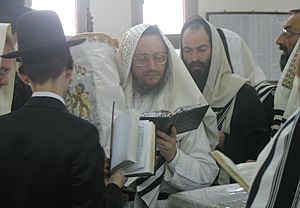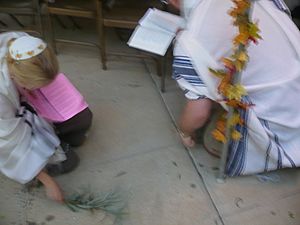Hoshana Rabbah facts for kids
Quick facts for kids Hoshana Rabbah |
|
|---|---|
| Official name | הוֹשַׁעְנָא רַבָּא |
| Also called | Translation: "The Great Supplication" |
| Observed by | Jews |
| Type | Jewish |
| Significance | The culmination of Sukkot. |
| Date | 21st day of Tishrei |
| 2024 date | Sunset, 22 October – nightfall, 23 October (24 October outside of Israel) |
| 2025 date | Sunset, 12 October – nightfall, 13 October (14 October outside of Israel) |
| 2026 date | Sunset, 1 October – nightfall, 2 October (3 October outside of Israel) |
| 2027 date | Sunset, 21 October – nightfall, 22 October (23 October outside of Israel) |
| Related to | Culmination of Sukkot (Tabernacles) |
Hoshana Rabbah (Imperial Aramaic: הוֹשַׁעְנָא רַבָּא, meaning "Great Supplication") is a special day in the Jewish calendar. It is the seventh and last day of the holiday of Sukkot. This day falls on the 21st day of the Jewish month of Tishrei.
On Hoshana Rabbah, Jewish people take part in a unique synagogue service. Worshippers walk around the synagogue seven times. They carry the lulav and etrog, which are special plants used during Sukkot. During these walks, the community recites prayers called Hoshanot. It is also a tradition to remove the Torah scrolls from their special ark during this procession. In some places, a shofar (a ram's horn trumpet) is blown after each walk.
Contents
What Hoshana Rabbah Means
A Day of Final Judgment
Hoshana Rabbah is seen as the last day of a period called the Days of Judgment. This period starts with Rosh Hashanah, the Jewish New Year. It continues through Yom Kippur, a day of forgiveness.
Jewish tradition teaches that decisions for the new year are made on Yom Kippur. However, these decisions are not "delivered" until Hoshana Rabbah. This means people still have a chance to change their fate for the coming year. Because of this, Jews often wish each other "pitka tava" (פתקא טבא) on Hoshana Rabbah. This is an Aramaic blessing meaning "a good note" or "a good verdict." In Yiddish, it's called "A guten kvitel."
To show the seriousness of the day, the Hazzan (cantor) often wears a kittel. This is a white robe worn on the High Holy Days. Hoshana Rabbah combines parts of the High Holy Days, regular festival days, and even weekly prayers. So, the cantor might use different melodies during the service.
Some Sephardic communities say special prayers called Selichot before the morning service. These are the same prayers said before Rosh Hashanah. In some places, the shofar is blown during the processions. This shows that Hoshana Rabbah marks the end of the High Holy Day season.
The Night Before Hoshana Rabbah
It is a custom for many to read the entire book of Psalms on the evening before Hoshana Rabbah. Some also read the book of Deuteronomy during this night.
Special Customs and Rituals
Many of the customs on Hoshana Rabbah have roots in Kabbalah, which is a mystical part of Jewish tradition.
Seven Circuits (Hakafot)
The way Hoshana Rabbah is celebrated today tries to copy what was done in the ancient Temple in Jerusalem. During Sukkot, people walk around the bimah (a raised platform in the synagogue) once a day. They carry the four species (lulav, etrog, myrtle, and willow). On Hoshana Rabbah, they make seven circuits, or hakafot.
Walking around the bimah with the four species comes from the Temple service. The Mishnah (an ancient Jewish text) says that priests would walk around the altar once each day of Sukkot. On the seventh day, they would walk seven times. This whole ceremony shows joy and thanks for a good and fruitful year. It also symbolizes breaking down barriers between people and God. It's like how the walls of Jericho fell after the Israelites walked around them.
According to Kabbalah, each of the seven circuits honors a special person from Jewish history. These are the same people invited to the sukkah during Sukkot.
- Abraham
- Isaac
- Jacob
- Moses (a very important prophet)
- Aaron (Moses's brother and the first high priest)
- Joseph (Jacob's famous son)
- David (a great king of Israel)
All-Night Learning (Tikkun Hoshana Rabbah)
Some Jewish communities have a tradition of staying up all night on the eve of Hoshana Rabbah. They spend the night studying Torah. This custom is called Tikkun Hoshana Rabbah.
Sephardic communities often stay up all night. They learn Torah in their synagogues. They might also say Selichot prayers. The entire book of Deuteronomy is often read. This is because Deuteronomy is seen as a review of the whole Torah. Also, this book is about to be finished in the weekly Torah reading cycle on Simchat Torah. Many also read the entire book of Psalms.
Beating Five Willow Branches
At the end of some special prayers, five willow branches are beaten on the ground or other surfaces. This action symbolizes getting rid of sins. It is also a prayer for rain and good crops. In Kabbalah, beating the willows helps to "sweeten" harsh judgments.
There is no blessing said for this ritual. People sometimes chant an Aramaic phrase: "chabit, chabit velah barich" (meaning "beat, beat but don't bless"). This custom is believed to have started later, during the time of the prophets Haggai, Zaqariah, and Malachi.
The Midrash (an ancient Jewish commentary) says that the Aravah (willow) represents ordinary people. These are people who might not be very learned or have many special deeds. Rabbi Abraham Isaac Kook explained that these simple people are important. They have common sense and are not held back by complicated thoughts. The custom of beating the willow shows that these ordinary people bring a natural, strong power to the Jewish people. We don't hit the willow itself; we hit with the willow.
Prayers for the Messiah
In some Jewish traditions, the hoshanot prayers include verses that express hope for the speedy arrival of the Messiah. One such verse is, "Kol mevasser, mevasser ve-omer" (The voice of the Herald [Elijah] heralds and says).
Traditional Foods
In Ashkenazi culture, it is common to eat soup with kreplach (dumplings) during the meal on Hoshana Rabbah.
Some Yiddish-speaking communities also eat boiled cabbage. This is because the Hebrew phrase "Kol Mevasser" (קול מבשר), chanted on this day, sounds like "koyl mit vasser" (קויל מיט וואסער) in traditional Eastern Ashkenazi pronunciation. "Koyl mit vasser" means "cabbage with water" in Yiddish.
Rabbi Pinchas of Koretz taught that one should bake an apple with a Hoshana branch inside it. This was believed to prevent toothaches in the coming year.
See also
 In Spanish: Hoshaná Rabá para niños
In Spanish: Hoshaná Rabá para niños



